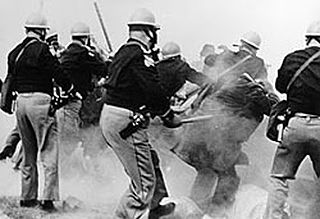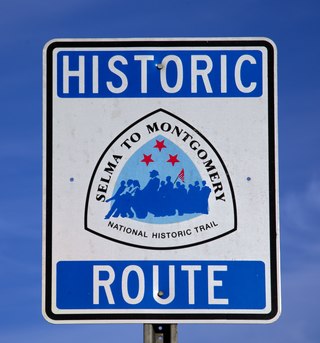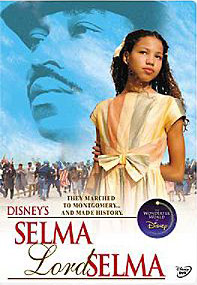
Dallas County is a county located in the central part of the U.S. state of Alabama. As of the 2020 census, its population was 38,462. The county seat is Selma. Its name is in honor of United States Secretary of the Treasury Alexander J. Dallas, who served from 1814 to 1816.

Selma is a city in and the county seat of Dallas County, in the Black Belt region of south central Alabama and extending to the west. Located on the banks of the Alabama River, the city has a population of 17,971 as of the 2020 census. About 80% of the population is African-American.

The Selma to Montgomery marches were three protest marches, held in 1965, along the 54-mile (87 km) highway from Selma, Alabama, to the state capital of Montgomery. The marches were organized by nonviolent activists to demonstrate the desire of African-American citizens to exercise their constitutional right to vote, in defiance of segregationist repression; they were part of a broader voting rights movement underway in Selma and throughout the American South. By highlighting racial injustice, they contributed to passage that year of the Voting Rights Act, a landmark federal achievement of the civil rights movement.

Amelia Isadora Platts Boynton Robinson was an American activist who was a leader of the American Civil Rights Movement in Selma, Alabama, and a key figure in the 1965 Selma to Montgomery marches. In 1984, she became founding vice-president of the Schiller Institute affiliated with Lyndon LaRouche. She was awarded the Martin Luther King Jr. Freedom Medal in 1990. Robinson was a centenarian reaching the age of 104.

James Joseph Reeb was an American Unitarian Universalist minister, pastor, and activist during the civil rights movement in Washington, D.C., and Boston, Massachusetts. While participating in the Selma to Montgomery marches actions in Selma, Alabama, in 1965, he was murdered by white segregationists and white supremacists, dying of head injuries in the hospital two days after being severely beaten. Three men were tried for Reeb's murder but were acquitted by an all-white jury. His murder remains officially unsolved.

The Selma to Montgomery National Historic Trail is a 54-mile (87 km) National Historic Trail in Alabama. It commemorates and marks the journey of the participants of the 1965 Selma to Montgomery marches in support of the Voting Rights Act.

James Gardner Clark, Jr. was the sheriff of Dallas County, Alabama, United States from 1955 to 1966. He was one of the officials responsible for the violent arrests of civil rights protestors during the Selma to Montgomery marches of 1965, and is remembered as a racist whose brutal tactics included using cattle prods against unarmed civil rights supporters.

Sheyann Webb-Christburg is a civil rights activist known as Martin Luther King Jr.'s "Smallest Freedom Fighter" and co-author of the book Selma, Lord, Selma. As an eight-year-old, Webb took part in the first attempt at the Selma to Montgomery march across the Edmund Pettus Bridge on March 7, 1965, known as Bloody Sunday.

James "Spider" Martin was an American photographer known for his work documenting the American Civil Rights Movement in 1965, specifically Bloody Sunday and other incidents from the Selma to Montgomery marches.

Jimmie Lee Jackson was an African American civil rights activist in Marion, Alabama, and a deacon in the Baptist church. On February 18, 1965, while unarmed and participating in a peaceful voting rights march in his city, he was beaten by troopers and fatally shot by an Alabama state trooper. Jackson died eight days later in the hospital.

Selma, Lord, Selma is a 1999 American made-for-television biographical drama film based on true events that happened in March 1965, known as Bloody Sunday in Selma, Alabama. The film tells the story through the eyes of an 9-year-old African-American girl named Sheyann Webb. It was directed by Charles Burnett, one of the pioneers of African-American independent cinema. It premiered on ABC on January 17, 1999.
Marie Priscilla Martin Foster was a leader in the Civil Rights Movement in the U.S. during the 1960s. Her successful voter registration in Dallas County, Alabama fueled her to become an activist, and she began teaching adult classes to help people pass the required literacy tests. She was the Alabama foot soldier that convinced Martin Luther King Jr. to come to Selma, Alabama and helped organize the Selma to Montgomery marches in 1965. Her dedication gave her the moniker "The Mother of the Voting Rights Movement," which was shortened to Mother Foster.

The Edmund Pettus Bridge carries U.S. Route 80 Business across the Alabama River in Selma, Alabama. Built in 1940, it is named after Edmund Pettus, a former Confederate brigadier general, U.S. senator, and state-level leader of the Alabama Ku Klux Klan. The bridge is a steel through arch bridge with a central span of 250 feet (76 m). Nine large concrete arches support the bridge and roadway on the east side.
JoAnne Bland is the co-founder and former director of the National Voting Rights Museum in Selma, Alabama. Bland was a highly active participant in the Civil Rights Movement from her earliest days, and was the youngest person to have been jailed during any civil rights demonstration during that period. Bland grew up in segregated Selma, Alabama, where she was not allowed to enter certain stores and was only allowed to go in the library and movie theater on days labeled "colored." As a result of growing up in segregation Bland lost her mother, who died in a "white" hospital waiting for a transfusion of "black blood." Her grandmother encouraged Bland and her sister to march and become a freedom fighter to fight for their freedom, even though her father disapproved due to his fear for their lives. Her father's objections did not stop Bland, who became active in the movement when she was eight years old. When she was eight years old, she attended a meeting with the Dallas County Voters League with her grandmother.
Annie Lee Wilkerson Cooper was an African-American civil rights activist. She is best known for punching Dallas County, Alabama Sheriff Jim Clark in the face during the 1965 Selma to Montgomery marches.
The history of the 1954 to 1968 American civil rights movement has been depicted and documented in film, song, theater, television, and the visual arts. These presentations add to and maintain cultural awareness and understanding of the goals, tactics, and accomplishments of the people who organized and participated in this nonviolent movement.

Frederick Douglas Reese was an American civil rights activist, educator and minister from Selma, Alabama. Known as a member of Selma's "Courageous Eight", Reese was the president of the Dallas County Voters League (DCVL) when it invited the Southern Christian Leadership Conference and Martin Luther King Jr. to Selma to amplify the city's local voting rights campaign. This campaign eventually gave birth to the Selma to Montgomery marches, which later led to the passage of the Voting Rights Act.
The Dallas County Voters League (DCVL) was a local organization in Dallas County, Alabama, which contains the city of Selma, that sought to register black voters during the late 1950s and early 1960s.

Women's suffrage in Alabama went through several stages. Early women's suffrage work in Alabama started in the 1860s. Priscilla Holmes Drake was the driving force behind suffrage work until the 1890s. Several suffrage groups were formed, including a state suffrage group, the Alabama Woman Suffrage Organization (AWSO). The Alabama Constitution had a convention in 1901 and suffragists spoke and lobbied for women's rights provisions. However, the final constitution continued to exclude women. Women's suffrage efforts were mainly dormant until the 1910s when new suffrage groups were formed. Suffragists in Alabama worked to get a state amendment ratified and when this failed, got behind the push for a federal amendment. Alabama did not ratify the Nineteenth Amendment until 1953. For many years, both white women and African American women were disenfranchised by poll taxes. Black women had other barriers to voting including literacy tests and intimidation. Black women would not be able to fully access their right to vote until the passage of the Voting Rights Act of 1965.















